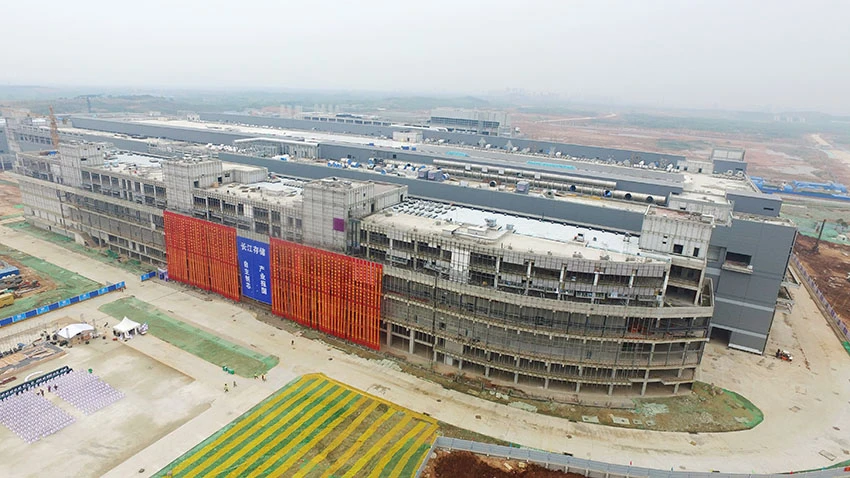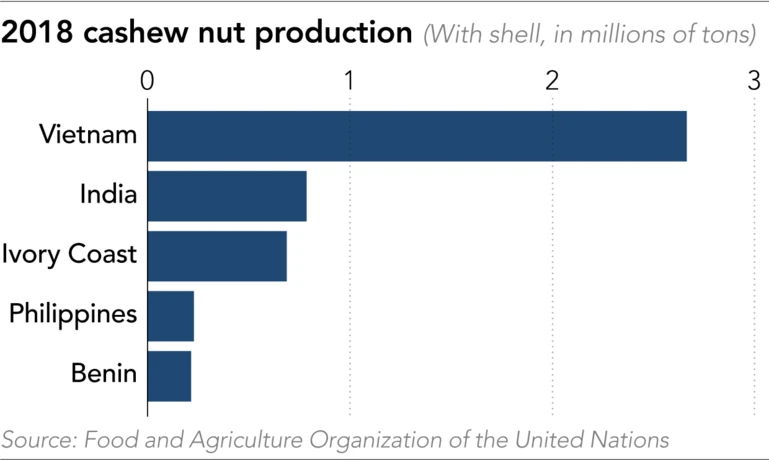
Vietnam's top two exports in 2018 in terms of value were smartphones, including mobile phones, which made up 20% of total exports, and apparel, accounting for 13%. Compared to these two cash cows, its cashew nut exports were small in value, belying the Southeast Asian country's position as the world's top producer of the commodity for the past 17 years.
According to the Food and Agriculture Organization of the United Nations, in 2018 Vietnam produced about 2.66 million tons of cashews, including their shells, a 23% increase from the previous year. That was 3.4 times more than India, the world's second biggest producer, which grew roughly 790,000 tons, making Vietnam the undisputed leader.
In 2018 Vietnam exported about 370,000 tons of the nuts, or 14% of its total production. That also makes the country the world's top exporter by volume, according to the Vietnam Cashew Association.
Vietnam's biggest cashew producing area is the southern province of Binh Phuoc. It is located north of the commercial center Ho Chi Minh City and to the west borders Cambodia's Kampong Cham Province, the birthplace of Hun Sen, the neighboring country's prime minister.
Strolling about Binh Phuoc, one often happens upon cashew trees, which are native to South America and covered with yellow, bell pepper-shaped "cashew apples." The comma-shaped seed under the apple is the cashew nut.

Vietnam has been producing cashews throughout the country since the early 1980s. Located in the humid tropics and blessed with large amounts of fertile red soil, provinces like Binh Phuoc and Dong Nai were designated as production zones. The Vietnamese government distributed seeds and fertilizer to farmers, and held lectures on cultivation techniques used overseas.
Major producer Lafooco, set up in 1985, worked with the government to get the industry up and running. Located in Long An Province, the company works about 620 hectares of fields in Binh Phuoc and elsewhere with organic farming techniques that meet U.S. and EU sanitary regulations.
"It was very hard for Vietnam's cashew nut industry to grow to this point," said Tra My Nguyen, vice chairwomen of The Pan Group, the parent company of Lafooco. "We still want to further improve the quality and appeal of our products and claim more of the global market."
 A worker oversees cashew nut processing at a factory owned by major Vietnamese producer Lafooco in Long An Province.
A worker oversees cashew nut processing at a factory owned by major Vietnamese producer Lafooco in Long An Province. Simple roasted cashews used to account for about 80% of the company's exports, but recently it has been selling products with added flavors at higher prices. Honey, coconut and chili flavorings are all popular.
Harvesting is a labor-intensive process. Many tasks, such as gathering the nuts, separating the seeds and removing the hard outer shell, require human workers. While automation is a growing part of the process, Vietnam's low labor costs remain the key pillar of the industry. The minimum wage increased an average of 5.5% in 2020, down significantly from 2013's 17.4% jump. But companies are still working to keep labor costs down by making their operations more efficient.
Numerous types of cashews are on sale at Vietnam's grocery stores and open-air markets. Many come with a thin skin still attached. Eaten freshly peeled, their texture is much better than cashews that are sold already peeled. But costing the equivalent of just under $2 per 100 grams, cashews are a bit expensive for average Vietnamese, meaning cheaper peanuts are more popular.




















